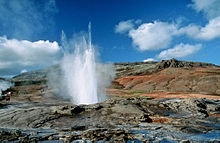Tourism in Iceland
The tourism is an important Icelandic industry. The share of the gross domestic product (GDP) was 4.1% in 2006. The share of those employed in the tourism industry was around 4% in 2000. In the Travel and Tourism Competitiveness Report 2017 of the World Economic Forum, Iceland ranks 25th out of 136 countries.
history
Tourism in Iceland increased significantly between 1950, when around 4,000 visitors came to Iceland, and 1995, when around 190,000 visitors. In the 1990s, the number of tourists rose again sharply; in 2000 there were just over 300,000 more tourists than Icelandic residents.
In parallel to the rising number of tourists, the number of overnight stays by foreign tourists increased. Between 1997 and 2008 alone they rose by 125%.
| year |
Share of tourism industry in GDP |
Employees in tourism |
Number of overnight stays (foreign tourists only) |
|---|---|---|---|
| 1997 | 461,595 | ||
| 1998 | 513.504 | ||
| 1999 | 553.501 | ||
| 2000 | 4.8% | 7,385 | 585.973 |
| 2001 | 5.0% | 7,622 | 624.003 |
| 2002 | 5.3% | 7,337 | 643.240 |
| 2003 | 4.6% | 7,365 | 716.416 |
| 2004 | 4.4% | 7,552 | 775,662 |
| 2005 | 4.2% | 7,923 | 817,500 |
| 2006 | 4.1% | 8.211 | 918.174 |
| 2007 | 1,015,715 | ||
| 2008 | 1,051,664 | ||
| 2009 | 1,074,134 | ||
| 2010 | 1,053,883 | ||
| 2011 | 1,214,240 | ||
| 2012 | 1,483,532 |
Almost 75% of the foreign visitors are travelers from Europe, especially from Germany , the United Kingdom , France and other Scandinavian countries . About 19% of tourists are from North America .
Tourist destinations
Iceland is shaped by both volcanism and large glaciers and lies directly on the border of two continental plates ( Eurasian plate and North American plate ).
The main travel season is in the summer months from June to August. This is also the time of the Icelandic school holidays and many boarding schools will then become summer hotels ( Edda hotels ). Not all hostels in Iceland are open all year round.
Popular destinations for short stays are the Bláa Lónið ( Blue Lagoon ) near the international airport Keflavík for swimming and the Golden Circle for day trips . There are also Þingvellir , the historic thing place of the Icelanders, the Haukadalur around the geyser and the Gullfoss waterfall . Destinations that are further away from the capital region are the Skaftafell National Park in the south and the Mývatn area in the north. Whale watching boat tours are offered from some coastal towns (for example Húsavík ).
The Silfra Fissure is not only ideal for divers and snorkelers because of the lava field formations and the crystal clear water. The Silfra Fissure lies on the continental rift ( Mid-Atlantic Ridge ) between America and Europe.
Equestrian holidays and riding tours with the Icelandic horse are just as popular . These range from short rides on riding stables to guided tours lasting several days, also on the highland paths or taking part in the sheep drive.
traffic
The island can be reached by plane or ferry . The Norröna car ferry operates between Denmark , the Faroe Islands and Iceland for passengers and vehicles .
The island can be circumnavigated in three days by bus. This tour can be interrupted at any time. On the ring road , you can drive around the island in any vehicle . All-terrain vehicles are required for excursions into the highlands or other remote areas.
Web links
- Icelandic Tourist Office
- Wikivoyage : Iceland
- official topographic maps of Ferðakort (English)
- Tourism statistics at the Statistical Office of Iceland (English)
- Travel portal for Iceland and collaboration platform for the Icelandic travel industry (German and English)







